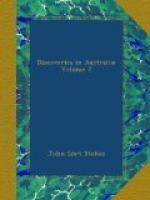SOLITARY ISLAND.
October 15.
In the evening the ship was anchored five miles from a small island, bearing South-South-East, which we found to be in latitude 19 degrees 55 minutes South, longitude 120 degrees 55 minutes East; and which, from its lonely situation, was named Solitary Island. Six and nine miles North by East from it we had crossed several lines of ripplings and shoal patches of 4 and 5 fathoms. On visiting it next morning (16th) it was found to be of red sandstone formation, thirty feet high, and devoid of vegetation. Although lying a mile from the shore it is connected at low-water by a flat of sand. From its summit the view of the interior presented a slight change. At the distance of six miles there was a bank or rise in the country having rather a fertile aspect, above a hundred feet high, trending South-West with dense woodland intervening.
On the same afternoon the ship was moved fourteen miles further on. The many patches of ripplings we now saw in every direction westward, assured us that the Amphinome Shoals were close at hand; on patches one and two miles west and south of the ship there was only six and nine feet.
VISIT THE SHORE.
October 17.
In the morning another party visited the shore, landing under a low sandhill, sixty feet high, bearing South by East six miles, called Mount Blaze, in latitude 20 degrees 0 minutes South and longitude 119 degrees 40 minutes East. This was found to stand on a projection, with two small rocky islets on either side. Eastward from it cliffy points separating shoal mangrove bays, formed the character of the coast; whilst in the opposite direction extended a bay, fifteen miles wide, over the western point of which we recognised the sandhills seen on our visit to this part in July, 1840; the shores of this great bay were fronted for some distance by shoal water.
Behind Mount Blaze the country was swampy, with mangroves, for a few miles; it then gradually rose, and on the bearing of South 7 degrees East, distant nearly fifteen miles, were seen conical-sided flat-topped hills about two hundred feet high. This was the first remarkable elevation in the country we had seen during the two hundred miles of the coastline traced by the Beagle; it appears to be the North-East termination of the high land seen southward from the Turtle Isles.
Some small burrowing animal had so excavated the ground in the vicinity of Mount Blaze, that at each step we sunk in knee-deep; a few quails were shot, but no varieties of birds were seen beyond what had been already observed at the other points of the coast visited.
Weighing, we stood to the westward, after making a short stretch to the north-east; but shoal water, at the end of six miles, obliged us to go on the other tack. The change in the direction of the flood- tide, from westerly to northerly, did not leave much hope of our finding a passage to the westward. At sunset the anchor was dropped in 9 fathoms, with a shoal patch of 5 fathoms two miles to the eastward, Mount Blaze, just visible from the masthead, bearing south sixteen miles. During the afternoon we had crossed no less than five lines of ripplings, on which, at low-water, there was only from 2 to 5 fathoms.




